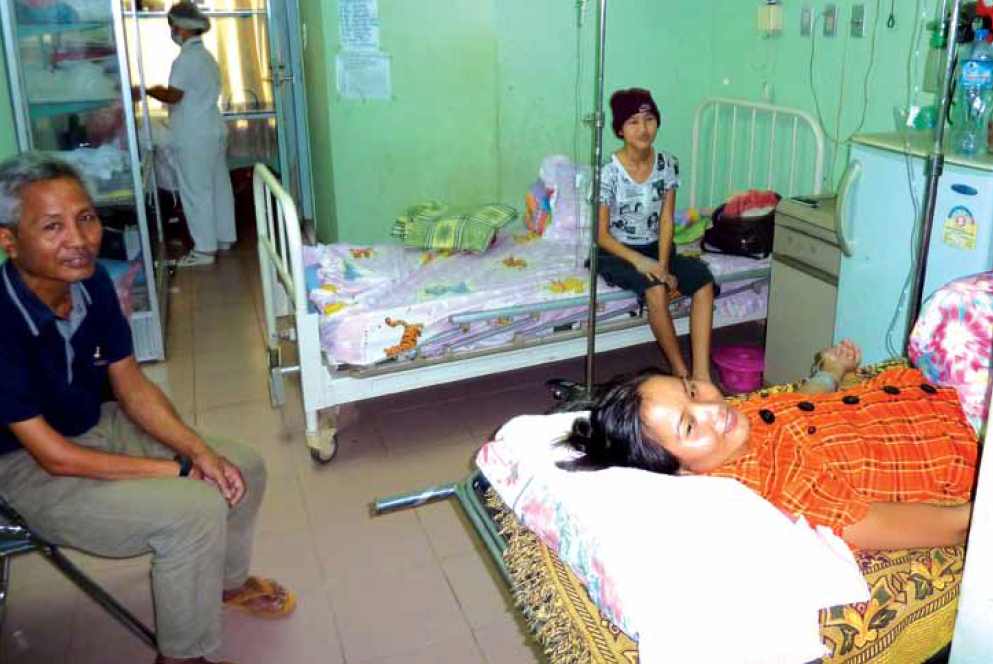For a large proportion of the women in the world, current advances in cancer care are of little benefit.
In 2000 there were an estimated ten million new cases of cancer and seven million deaths worldwide, with 53 per cent of the incidence and 56 per cent of the deaths in developing countries. It is projected that, by 2020, the incidence of cancer will increase by a staggering 73 per cent in developing countries. Cancer mortality rates in developing countries are expected to be five times higher than in the developed world.1 About 80 per cent of cervical cancers occur in developing countries that lack effective screening, detection and treatment programs.2 It can be misleading to group all developing countries together as development occurs at different rates. Nevertheless, an overview of the issues we see in the country in which I work, Laos, gives some idea of the issues that affect cancer prevention and treatment for women in low-resource settings.
A huge problem in Laos is the lack of health awareness among the population. This is hardly surprising, given the rudimentary education systems and low standards of teacher training. The adult literacy rate for women is said to be around 60 per cent and in a recent study relating to cervical screening in rural areas where about 80 per cent of Lao women live, 11 per cent had no schooling, while 52 per cent had only completed primary school.2 The study found women’s main sources of information on health issues were the television, 47 per cent; healthcare providers, 30 per cent; and friends 23 per cent. An unpublished study by the same authors demonstrated that, among healthcare providers, only 20 per cent had ever advised a woman to seek cervical cancer screening and over one-third believed cervical cancer was untreatable. Of the female providers surveyed, less than one-quarter had ever sought cervical screening. Their level of knowledge regarding reproductive cancers was very poor. For these reasons, most gynaecological cancers are in advanced stages at the time of diagnosis.
Where cancers are diagnosed at an advanced stage, cure rates with the best treatments are low and it is easy for an attitude of hopelessness to develop. Soon after I arrived in Laos I gave a series of talks to workers from rural health centres. Their own education was very poor, with most having no more than a year of formal training and about half of them having only completed primary education. One of the participants said, ‘It seems pointless to treat cancer, because all the women I see with cancer die, regardless of treatment.’ This is a not unreasonable observation, given the advanced stage of disease. Another important factor is that the families of those treated are considerably poorer after their death, given the cost of healthcare relative to the income of the population.
The cost of healthcare in Laos must take into account more than the fees charged and the cost of diagnostic procedures, drugs and disposables. The cost of transportation to a healthcare facility can be considerable, especially if the visit is to one of the central hospitals in Vientiane. If inpatient care is required, relatives are needed in the hospital at all times to undertake basic nursing care, visit the pharmacy for drugs and buy and give food to the patient. While one relative can usually sleep on the floor of the ward, for a second person the cost of accommodation must be factored in. In a country where 80 per cent of the population survive on US$2 per day, often from a farm or family business, the loss of productivity caused by having the patient and carers off work is a heavy burden.
In the villages, where the majority of Lao live, basic drug kits are available, but there is no trained healthcare provider. There are about 750 health centres where primary care is provided by health professionals with basic training: each health centre serves 1000–7000 people. While access to these centres is relatively easy, the services offered are limited. There are around 150 district hospitals, most served by medical assistants, nurse assistants and sometimes by trained nurses with or without doctors. These personnel are poorly trained, paid and supported in terms of professional development. Provincial hospitals, of which there are 13, have trained nurses and sometimes trained midwives and specialists. The five central hospitals in Vientiane have the highest proportion of staff with specialist training, but their knowledge and skill levels, especially in relation to malignant disease, are very poor.
In the villages, where the majority of Lao live, basic drug kits are available, but there is no trained healthcare provider. There are about 750 health centres where primary care is provided by health professionals with basic training: each health centre serves 1000–7000 people. While access to these centres is relatively easy, the services offered are limited. There are around 150 district hospitals, most served by medical assistants, nurse assistants and sometimes by trained nurses with or without doctors. These personnel are poorly trained, paid and supported in terms of professional development. Provincial hospitals, of which there are 13, have trained nurses and sometimes trained midwives and specialists. The five central hospitals in Vientiane have the highest proportion of staff with specialist training, but their knowledge and skill levels, especially in relation to malignant disease, are very poor.
Pathology services are rudimentary. Anatomical pathology and cytology are based in Vientiane, posing major problems of access for the rural population. When a specimen is sent, and even in the major teaching hospital it is often not, it is carried by the patient’s relatives to the laboratory, the processing fee is paid and the relative told to return on a set day, collect the results and take them to the doctor. The same is true for Pap smears. There are many problems with this system. It is not uncommon for the relatives to discard the specimen owing to a failure to understand the importance of the examination or the cost. Pathology reports are written in either French or English by pathologists, and referring doctors often have no real understanding of the significance of the report, so problems may be overlooked.
A good example of difficulties with the system is provided by a malignant germ cell tumour in a 15-year-old girl that was reported as an immature teratoma, grade 1 on the basis of four blocks from a 20cm tumour. The diagnosis was subsequently found to be incorrect, but the referring doctor mistook ‘immature teratoma’ for a mature teratoma or dermoid cyst and mistakenly reassured her and her family that all was well when a 10cm pelvic mass was found six months later.

Two young women referred for very advanced recurrent germ cell tumours about to get BEP chemo after reoperation. The younger is 15, the older 18. The father of the older girl will manage the drips after the nurse departs.
It was a further five months before she visited a central hospital with a tumour extending from the pelvis to the xiphisternum. Tumour markers suggested a mixed germ cell malignancy that, fortunately, was resectable with conservation of ovarian tissue and after chemotherapy (paid for by a charitable trust) her hair has regrown and her periods returned with apparent cure.
Many patients choose to travel to neighbouring countries for diagnostic or therapeutic services that are very expensive by Lao standards, but perceived to be of a better standard. Often, patients run out of money before they can get treatment there and return home, poorer but untreated, to seek care locally. Radiotherapy is not available in Laos, so women with advanced or recurrent cervical cancer have to travel out of the country for this treatment. Patients frequently complain of poor communication on the part of the foreign doctors, which is hardly surprising given differences in language. Payment is required prior to treatment and can rapidly exhaust the resources of the family. Furthermore, radiation requires the patient to be near to the treating hospital for about six to eight weeks, imposing a further burden for food, accommodation and lost productivity.
Palliative care is almost unheard of in Laos. The problems experienced by women dying of advanced cancer are rarely seen by doctors because when patients determine that cure is not possible they return home to die – to ensure that their spirits do not wander searching for home and for social and economic reasons. One doctor has been campaigning to have oral morphine preparations made available in addition to the injectable forms, but the government has refused because of a fear of drugs being sold on to addicts, which is a possibility. A woman who has worked tirelessly throughout her life to help provide the best possible future for her family will frequently count her suffering of little account compared to how the cost of her care will affect the family in the longer term.
There are lessons to learn for us all from the issues evident in this country: even Western economies cannot continue to support uncontrolled expenditure on healthcare; and it can be rational for a person to refuse treatment where she perceives that the costs may be greater than the benefits treatment could bring. And, of course, it is important to recognise the great disadvantage suffered by those with poor educational backgrounds and low socioeconomic status. In Australia one thinks particularly of Aboriginal and Torres Strait Islanders with their excessive burden of morbidity and mortality from all diseases, including gynaecological cancer. Overall, Lao women remind me of the amazing resilience of the human spirit in the face of adversity, and the need to strive to respond as positively as possible to the circumstances to provide the best possible care.
References
- Wilson CM, Tobin S, Young RC. The exploding worldwide cancer burden: the impact of cancer on women. Int J Gynecol Cancer 2004; 14: 1-11.
- Kanovis P. The rising burden of cancer in the developing world. Annals of Oncology 2006; 17: (Supplement 8) viii5-viii23.
- Phongsavan K, Phengsavanh A, Wahlstrom R, Marions L. Women’s perception of cervical cancer and its prevention in rural Laos. Int J Gynecol Cancer 2010; 20: 821-826.






Leave a Reply